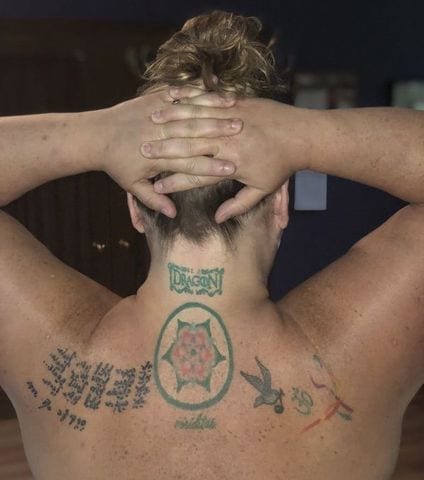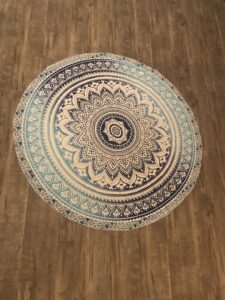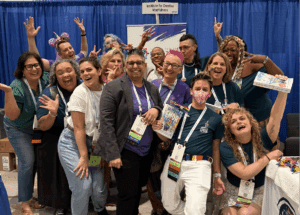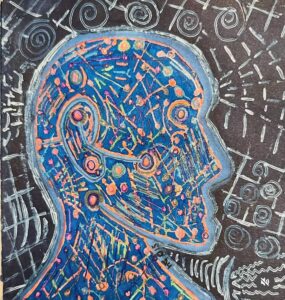When I was twenty years old, I woke up one morning and knew I had to get a tattoo. I made the decision in a blend of peer pressure (my childhood best friend just got several) and being hungover. I knew that, whatever I got, I’d have to place it somewhere I could hide it; I chose my right hip. My friend Heather and I made our way to Artistic Dermographics in Boardman, OH and I looked through scores of design books. I asked myself: “If this thing is going to be on my body forever, what wouldn’t I mind having on me at 90?” I found a lovely design—a purplish peace lily growing out of a peace sign. I loved it because I love peace. The image also represented a bit of rebellion against an Evangelical church I was just coming out of that condemned the peace sign as somehow anti-Christian.
I loved getting my first tattoo! Call me weird, I found the pressure of the needles very relaxing; it put me to sleep! While others have hurt like hell (the foot and upper middle back being the worst), there are such wonderful memories accompanying every tattoo—beautiful connections to their meanings, and what I was going through in life during each of them. To look at me you wouldn’t think I’d be too into ink. All my tattoos are in places I could cover if I had to although the older I’m getting and the less I care what others think, the less I want to cover them!
My latest tattoo led to a fascinating discussion with a friend that got the wheels in my head turning about tattoos and their meanings to the individual. Tattoo #8, on my left upper back, is my favorite poem “Blessed is the Match” by Hannah Senesh. I’ve written about my connection to her and this poem on the blog before. Quite frankly, I’ve yearned for some reminder of this poem and its meaning to me on my body for years. I thought about getting a match tattoo, a flame, or the poem in English, but nothing ever resonated. On a recent visit to Israel, a friend shared an online photo of the poem in her original handwriting from 1944. As soon as I saw it, I knew that this was the tattoo. This experience parallels the one I’ve had with every other tattoo on my body. I typically sit with an idea but then wait until the exact design hits me like lightning!
It’s not lost on me that tattoos are generally taboo in traditional Judaism. Between their forbiddance in strict interpretations of kosher law and the historical associations around tattoos as branding emerging from the tragic legacy of the Holocaust, I did reflect on what it would mean for me—a non-Jew—to get this piece permanently affixed on my body. And from these contemplations and meditations arose many of the thoughts I share in this piece.
In my reflections, it dawned on me what all my tattoos have in common. They all represent protector figures—people or ideas that I know exist within me and in the spiritual realm that support me in my healing journey. We talk about protector figures quite a bit in trauma-focused therapy. It means a great deal to my expressive arts therapist soul to have several of my figures literally with me on my body—the peace lily which I came to associate with St. Therese of Lisieux (“The Little Flower”), the Blessed Mother (my foot), St. Hildegard of Bingen (upper back and left forearm), Khaleesi from Game of Thrones (back of the neck), and the ideals of music, art, dance, and yoga (upper right back). The next one I am planning (the art is still in process) will likewise reflect the wisdom of another protector figure.
In addition to the protector figure quality, all my tattoos represent a life credo, a sacred message that transformed me when I received it and highlighted itself as a truth I needed to embrace. The most powerful example is a Latin saying on my left forearm: vis medicatrix naturae (the healing power of the natural state). I received this teaching in Bingen, Germany while on a Hildegard retreat and pilgrimage in 2016 and I knew instantly that I had to get this anthem of authenticity placed on my left side (where we in the West wear wedding rings), right along the heart line. I see the message often on my arm when I dance and practice yoga. I smile at the reminder that embracing the fullness of my authentic self ultimately freed me from bondage. When people ask me what the saying means, I delight to share the translation and its teaching. The unexpected gift of tattoos is to educate others when curiosity leads them to ask questions, just as I have learned much from other people when I ask about their tattoos. In the two weeks since I got “Blessed is the Match,” I told Hannah’s story to dozens of people who asked about it. Not enough people know about Hannah and her heroism and more people need to, and if my tattoo can help me to share it, I am glad it can serve that higher purpose.
In my reflections I also realized that if I were to die tomorrow, whoever found me could look at my body and know what I stood for. In these scary times in which we find ourselves, where the different are persecuted—where a Hannah Senesh-level stand may be required of me someday—there is no hiding who I am and what I am about. I strategically placed the tattoo on my neckline for this reason. My neck bears the phrase Be a Dragon, the guidance given to my favorite feminist icon Daenerys Targaryan (Khaleesi) in the televised Game of Thrones saga. I’ve long adored dragons as misunderstood wonders of the mythological realm, and when George R.R. Martin literally gave me a badass dragon queen to admire through his work, the universe smiled upon me.
In Season 7 Lady Olena, another badass feminist, warns Daenerys not to play small for the men. She declared, “The men of Westeros are sheep. Are you a sheep? No. You’re a dragon. Be a dragon.” I wept, trembled, sobbed, and ugly cried in every possible way when this scene played in the early summer of 2017. I knew that if the current U.S. political regime and the forces it represents would ever come after my head either literally or figuratively, I want this message to be the last thing that they see. Many others around the globe choose the neckline for this reason and I take great pride in following their example in honoring my life path on my body, in my heart, and with my soul.
Many of you reading this piece have your own stories of experience, empowerment, and meaning connected to your tattoos. Please consider sharing them in the comments below or, if you wish, submit your story to me as I work with expanding this series on Tattoos and Trauma Recovery. Please send any submissions to: support@instituteforcreativemindfulness.com. You may choose to be credited for your contribution or remain anonymous.
I loved getting my first tattoo! Call me weird, I found the pressure of the needles very relaxing; it put me to sleep! While others have hurt like hell (the foot and upper middle back being the worst), there are such wonderful memories accompanying every tattoo—beautiful connections to their meanings, and what I was going through in life during each of them. To look at me you wouldn’t think I’d be too into ink. All my tattoos are in places I could cover if I had to although the older I’m getting and the less I care what others think, the less I want to cover them!
My latest tattoo led to a fascinating discussion with a friend that got the wheels in my head turning about tattoos and their meanings to the individual. Tattoo #8, on my left upper back, is my favorite poem “Blessed is the Match” by Hannah Senesh. I’ve written about my connection to her and this poem on the blog before. Quite frankly, I’ve yearned for some reminder of this poem and its meaning to me on my body for years. I thought about getting a match tattoo, a flame, or the poem in English, but nothing ever resonated. On a recent visit to Israel, a friend shared an online photo of the poem in her original handwriting from 1944. As soon as I saw it, I knew that this was the tattoo. This experience parallels the one I’ve had with every other tattoo on my body. I typically sit with an idea but then wait until the exact design hits me like lightning!
It’s not lost on me that tattoos are generally taboo in traditional Judaism. Between their forbiddance in strict interpretations of kosher law and the historical associations around tattoos as branding emerging from the tragic legacy of the Holocaust, I did reflect on what it would mean for me—a non-Jew—to get this piece permanently affixed on my body. And from these contemplations and meditations arose many of the thoughts I share in this piece.
In my reflections, it dawned on me what all my tattoos have in common. They all represent protector figures—people or ideas that I know exist within me and in the spiritual realm that support me in my healing journey. We talk about protector figures quite a bit in trauma-focused therapy. It means a great deal to my expressive arts therapist soul to have several of my figures literally with me on my body—the peace lily which I came to associate with St. Therese of Lisieux (“The Little Flower”), the Blessed Mother (my foot), St. Hildegard of Bingen (upper back and left forearm), Khaleesi from Game of Thrones (back of the neck), and the ideals of music, art, dance, and yoga (upper right back). The next one I am planning (the art is still in process) will likewise reflect the wisdom of another protector figure.
In addition to the protector figure quality, all my tattoos represent a life credo, a sacred message that transformed me when I received it and highlighted itself as a truth I needed to embrace. The most powerful example is a Latin saying on my left forearm: vis medicatrix naturae (the healing power of the natural state). I received this teaching in Bingen, Germany while on a Hildegard retreat and pilgrimage in 2016 and I knew instantly that I had to get this anthem of authenticity placed on my left side (where we in the West wear wedding rings), right along the heart line. I see the message often on my arm when I dance and practice yoga. I smile at the reminder that embracing the fullness of my authentic self ultimately freed me from bondage. When people ask me what the saying means, I delight to share the translation and its teaching. The unexpected gift of tattoos is to educate others when curiosity leads them to ask questions, just as I have learned much from other people when I ask about their tattoos. In the two weeks since I got “Blessed is the Match,” I told Hannah’s story to dozens of people who asked about it. Not enough people know about Hannah and her heroism and more people need to, and if my tattoo can help me to share it, I am glad it can serve that higher purpose.
In my reflections I also realized that if I were to die tomorrow, whoever found me could look at my body and know what I stood for. In these scary times in which we find ourselves, where the different are persecuted—where a Hannah Senesh-level stand may be required of me someday—there is no hiding who I am and what I am about. I strategically placed the tattoo on my neckline for this reason. My neck bears the phrase Be a Dragon, the guidance given to my favorite feminist icon Daenerys Targaryan (Khaleesi) in the televised Game of Thrones saga. I’ve long adored dragons as misunderstood wonders of the mythological realm, and when George R.R. Martin literally gave me a badass dragon queen to admire through his work, the universe smiled upon me.
In Season 7 Lady Olena, another badass feminist, warns Daenerys not to play small for the men. She declared, “The men of Westeros are sheep. Are you a sheep? No. You’re a dragon. Be a dragon.” I wept, trembled, sobbed, and ugly cried in every possible way when this scene played in the early summer of 2017. I knew that if the current U.S. political regime and the forces it represents would ever come after my head either literally or figuratively, I want this message to be the last thing that they see. Many others around the globe choose the neckline for this reason and I take great pride in following their example in honoring my life path on my body, in my heart, and with my soul.
Many of you reading this piece have your own stories of experience, empowerment, and meaning connected to your tattoos. Please consider sharing them in the comments below or, if you wish, submit your story to me as I work with expanding this series on Tattoos and Trauma Recovery. Please send any submissions to: support@instituteforcreativemindfulness.com. You may choose to be credited for your contribution or remain anonymous.
Photography: Mary Riley




